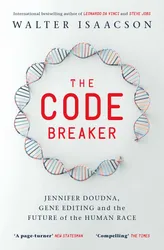This book is partly a biography of Jennifer Doudna, and partly a telling of the story of how the CRISPR process was discovered and turned into a tool for editing the DNA in human (and other) cells.
The science itself is really fascinating, and proceeds from the discovery of the structure of DNA in the 1950s. The name CRISPR is an acronym for ‘clustered regularly interspaced short palindromic repeats’ and was first noticed by scientists, such as Francisco Mojica, who became curious about these repeating sequences of DNA in certain archea and bacteria. This led to the understanding that these repeats were a system for fighting viruses in bacteria, and later to the realisation that the building blocks of CRISPR could be used as a system for editing DNA, including in human cells.
The book goes quite deeply into the biology, although almost all the images in the book are photographs of the scientists involved, emphasising the human aspect of these scientific discoveries, both in terms of collaboration and competition. These two aspects of the progress of science are woven throughout this book. Doudna herself is portrayed as someone who really values collaboration with her fellow scientists. But she is also competitive, and if her lab has the chance to make (and publish) a discovery first, she will do everything it takes to beat a rival lab (fairly, of course!).
The author seems to have gained a lot of access to Doudna during the writing of this book, even going as far as learning how to edit DNA in her lab, taught by some of her postdocs. Other key figures in the race to discover and perfect the CRISPR system, such as Feng Zhang, also appear and were interviewed by the author, but we get a less complete portrayal of them in this book than we do of Jennifer Doudna.
The story is bookended by some chapters about the Covid-19 pandemic. Since the virus that causes Covid-19 is an RNA virus and Doudna is an expert in RNA, it made sense for her to co-ordinate efforts to help with testing and attempting to use CRISPR to treat the virus, and I can see why the author was keen to include this part of the story; we were all coronavirus-obsessed in 2020. But as far as I know, CRISPR-related technologies weren’t particularly significant in either the testing rollout, the development of vaccines, or the production of anti-viral medications for Covid-19. The only articles I can find relating CRISPR to Covid were basically press releases from 2020 saying that it could be useful. Probably the pandemic came along a bit too early for CRISPR to play a significant role. No doubt, CRISPR will be of greater and greater significance in the years to come, and maybe even for future pandemics. But I wonder if this section of the book will seem rather dated and irrelevant in a few years time.
One section that is likely to become more relevant over time is the one discussing the ethical implications of gene editing, particularly in making germline edits that would be passed on to an individual’s descendents. These ethical dilemmas are well explained and thoughtfully discussed, although there are of course no easy answers.
I only had a vague idea what CRISPR was before I read this book, and now I feel I know quite a lot about it. I loved the portrayal of science and scientists in this book; the collaboration, the competition, the curious and sometimes obsessive personalities involved. It’s a really great story and understanding CRISPR, what it is, how it was developed, and what it can do, is likely to be of great importance in the coming years. This book is a good guide to this area of science.
